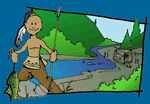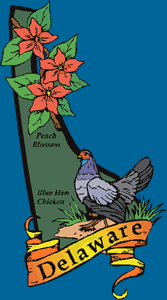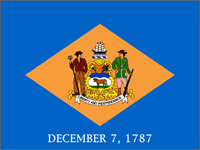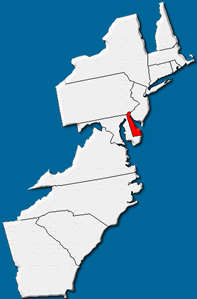


Geography and Landforms:
The state of Delaware consists of two major land regions: The Piedmont and the Atlantic Coastal Plain. The Piedmont, an area of gently rolling hills found in the northwest corner of the state, is 10 miles wide at its widest point. The highest point in Delaware, just 450 feet above sea level, is found in the Piedmont. The Atlantic Coastal Plain stretches across the rest of the state. It is a low, flat region that rises only about 80 feet above sea level. A 30,000-acre swamp lies along southern boundary of the state. A long sand bar -- 28 miles long -- forms a border with the Atlantic Ocean. This sandy strip to the east is a popular vacation region.
|
 History:
The history of Delaware begins with the early explorations of the Portuguese, Spaniards, and Dutch. The name of the state can be traced to an event that occurred in 1610. While attempting to seek shelter from a storm, English Captain Samuel Argall of the Virginia Colony sailed into a body of water that he later named the De Le Warr Bay, in honor of Virginia's governor, Lord De La Warr.
|
 Economy:
The city of Wilmington, Delaware is the heart of the state's economy. This city is home to the DuPont Company - one the largest chemical companies in the world. DuPont has developed such well-known products as Nylon, Teflon, Cellophane, Stainmaster carpets, and Lycra brand spandex.
|
 First Inhabitants:European explorers reached the coast of what is now our nation's first state during the 16th and early 17th centuries. They found the region already populated by tribes of Algonkian Indians. These groups of Native Americans were among the first to come into contact with early settlers. The Leni-Lenape tribe lived along the Delaware River to the north. The Nanticoke tribe occupied the area along the Nanticoke River in the southwestern part of the region. Because they lived close to the Delaware River and Bay, these Native Americans became known as the Delaware. |
Books Related To DelawareBewildered for Three Days - Andrew Glass F is for First State: A Delaware Alphabet - Carol Crane The Heights, the Depths, and Everything in Between - Sally Nemeth Hill Hawk Hattie - Clara Gillow Clark Jasper Dash and the Flame Pits of Delaware - M.T. Anderson The Light in the Forest - Conrad Richter Reaching Tidewater - Noreen Moore Water Rat - Marnie Laird |
Famous Citizens:
|
| Capital: | Dover |
| Entered Union: | December 7, 1787 |
| Population: | 935,614 |
| Area | 2,489 |
| Bird | Blue Hen Chicken |
| Flower | Peach Blossom |
| Nickname: | The First State, The Diamond State |
| Governor | Jack Markell |
Places to Visit in Delaware: (Click the links to learn more.)
|



